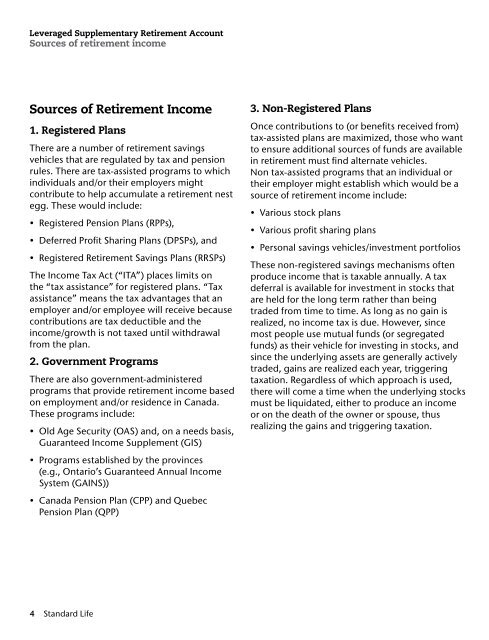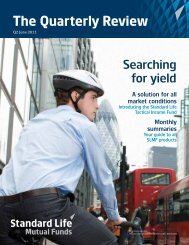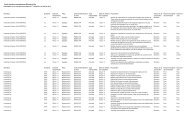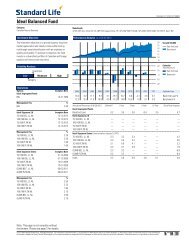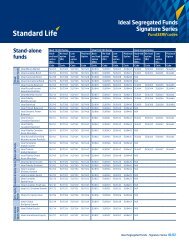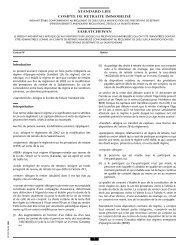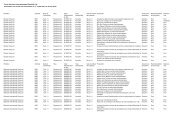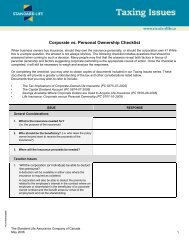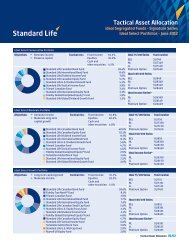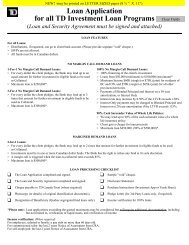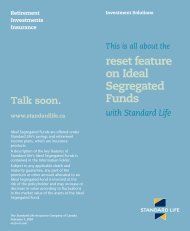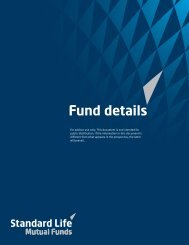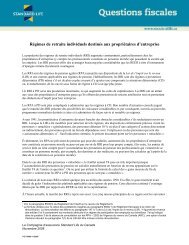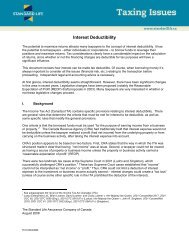Leveraged Supplementary Retirement Account - Standard Life
Leveraged Supplementary Retirement Account - Standard Life
Leveraged Supplementary Retirement Account - Standard Life
Create successful ePaper yourself
Turn your PDF publications into a flip-book with our unique Google optimized e-Paper software.
<strong>Leveraged</strong> <strong>Supplementary</strong> <strong>Retirement</strong> <strong>Account</strong><br />
Sources of retirement income<br />
Sources of <strong>Retirement</strong> Income<br />
1. Registered Plans<br />
There are a number of retirement savings<br />
vehicles that are regulated by tax and pension<br />
rules. There are tax-assisted programs to which<br />
individuals and/or their employers might<br />
contribute to help accumulate a retirement nest<br />
egg. These would include:<br />
•<br />
•<br />
Registered Pension Plans (RPPs),<br />
Deferred Profit Sharing Plans (DPSPs), and<br />
• Registered <strong>Retirement</strong> Savings Plans (RRSPs)<br />
The Income Tax Act (“ITA”) places limits on<br />
the “tax assistance” for registered plans. “Tax<br />
assistance” means the tax advantages that an<br />
employer and/or employee will receive because<br />
contributions are tax deductible and the<br />
income/growth is not taxed until withdrawal<br />
from the plan.<br />
2. Government Programs<br />
There are also government-administered<br />
programs that provide retirement income based<br />
on employment and/or residence in Canada.<br />
These programs include:<br />
• Old Age Security (OAS) and, on a needs basis,<br />
Guaranteed Income Supplement (GIS)<br />
• Programs established by the provinces<br />
(e.g., Ontario’s Guaranteed Annual Income<br />
System (GAINS))<br />
• Canada Pension Plan (CPP) and Quebec<br />
Pension Plan (QPP)<br />
4 <strong>Standard</strong> <strong>Life</strong><br />
3. Non-Registered Plans<br />
Once contributions to (or benefits received from)<br />
tax-assisted plans are maximized, those who want<br />
to ensure additional sources of funds are available<br />
in retirement must find alternate vehicles.<br />
Non tax-assisted programs that an individual or<br />
their employer might establish which would be a<br />
source of retirement income include:<br />
•<br />
•<br />
Various stock plans<br />
Various profit sharing plans<br />
• Personal savings vehicles/investment portfolios<br />
These non-registered savings mechanisms often<br />
produce income that is taxable annually. A tax<br />
deferral is available for investment in stocks that<br />
are held for the long term rather than being<br />
traded from time to time. As long as no gain is<br />
realized, no income tax is due. However, since<br />
most people use mutual funds (or segregated<br />
funds) as their vehicle for investing in stocks, and<br />
since the underlying assets are generally actively<br />
traded, gains are realized each year, triggering<br />
taxation. Regardless of which approach is used,<br />
there will come a time when the underlying stocks<br />
must be liquidated, either to produce an income<br />
or on the death of the owner or spouse, thus<br />
realizing the gains and triggering taxation.


